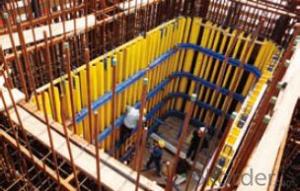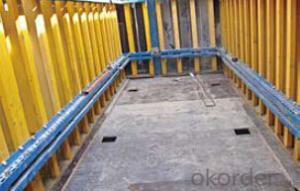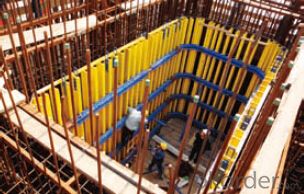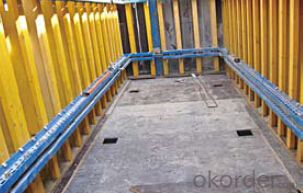Shaft-platform system for Formwork and Scaffolding
- Loading Port:
- Tianjin
- Payment Terms:
- TT OR LC
- Min Order Qty:
- 50 m²
- Supply Capability:
- 1000 m²/month
OKorder Service Pledge
Quality Product, Order Online Tracking, Timely Delivery
OKorder Financial Service
Credit Rating, Credit Services, Credit Purchasing
You Might Also Like
Shaft Platform
As operating platform, the shaft platform is mainly used in the concrete pouring of elevator shaft,
equipment shaft, stair shaft of high-rise building and so on.
Characteristics:
◆ The length of shaft beam is adjustable.
◆ Flexible structure makes lifting easier.
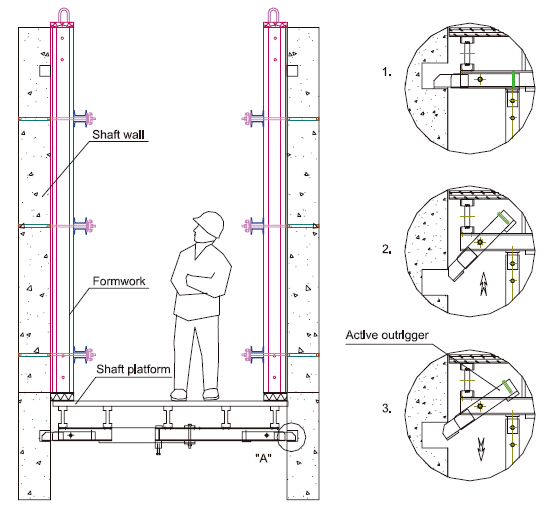
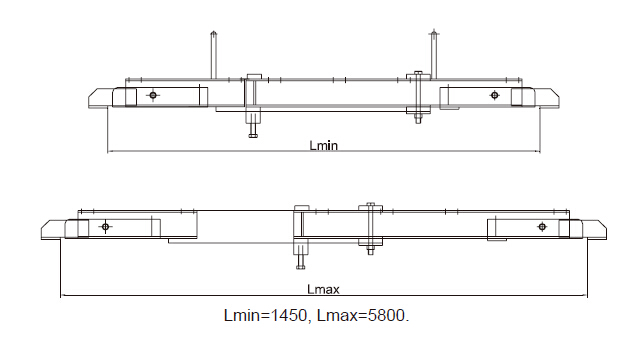
- Q: How does steel formwork contribute to the overall sustainability of the project?
- Steel formwork contributes to the overall sustainability of a project in several ways. Firstly, steel is a highly durable material that can withstand heavy loads and repeated use. This means that steel formwork can be used for multiple construction cycles, reducing the need for new formwork materials and minimizing waste. Additionally, steel formwork is highly versatile and can be easily customized to fit various design requirements. This flexibility allows for efficient use of materials and reduces the amount of construction waste generated. Moreover, steel formwork is highly recyclable. At the end of its life cycle, steel formwork can be easily dismantled and recycled, reducing the demand for new steel production and minimizing the environmental impact associated with mining and manufacturing new materials. Furthermore, steel formwork offers better quality control compared to traditional timber formwork. It provides precise and consistent dimensions, resulting in an accurate and high-quality final product. This reduces the need for rework and ensures less material wastage. Lastly, the use of steel formwork can also lead to shorter construction periods. The quick assembly and disassembly of steel formwork allows for faster construction processes, reducing the overall energy consumption and carbon emissions associated with the project. In conclusion, steel formwork contributes to the overall sustainability of a project through its durability, recyclability, versatility, and efficiency. By reducing waste, minimizing environmental impact, and improving construction processes, steel formwork helps create more sustainable and environmentally-friendly construction projects.
- Q: What are the different types of formwork accessories used with steel formwork?
- Steel formwork commonly utilizes various types of formwork accessories to enhance functionality, efficiency, and worker safety during construction. 1. Formwork clamps securely fasten formwork panels together, ensuring their stability and preventing movement during concrete pouring. They come in different sizes and designs to accommodate various formwork systems. 2. Formwork props are adjustable steel supports used to provide vertical stability and load-bearing capacity to formwork panels. This ensures worker safety while operating on the system. 3. Formwork ties firmly hold formwork panels in place, preventing bulging or deflection under the weight of concrete. Made of steel, they are available in different lengths and designs to meet project requirements. 4. Formwork connectors join formwork panels at corners or joints, ensuring a tight and secure fit. They come in various shapes and sizes, including corner connectors, wedge connectors, and pin connectors. 5. Formwork brackets support formwork panels horizontally, providing additional stability and reinforcement. They are commonly used in beam and slab construction to support formwork across long spans. 6. Formwork release agents are chemical substances applied to the formwork surface to prevent concrete adhesion. This allows for easy removal of the formwork after concrete curing, facilitating efficient and smooth formwork removal. In conclusion, these formwork accessories are vital for the success of a steel formwork system, providing the necessary support, stability, and reinforcement for efficient and safe construction of concrete structures.
- Q: How does steel formwork handle different concrete slump flow measurements?
- Steel formwork offers versatility and durability when dealing with various measurements of concrete slump flow. Slump flow is a gauge of concrete's consistency and workability, indicating its capacity to flow and fill the formwork. Designed to be rigid and robust, steel formwork can withstand the weight and pressure of poured and cured concrete. This ensures that it effectively contains and supports concrete with different slump flow measurements, preventing any deformation or failure. One advantage of steel formwork lies in its ability to easily adapt to changes in concrete slump flow. It can be adjusted or modified to accommodate varying levels of fluidity and workability. By tightening or loosening the formwork panels, the desired shape and size can be achieved, ensuring proper containment and shaping of the concrete, regardless of its slump flow measurement. Furthermore, steel formwork provides a smooth and uniform surface for the concrete, which is crucial for achieving a high-quality finish. The steel's rigid structure guarantees that the formwork remains in place during the pouring process, minimizing the risk of any movement or displacement that could negatively affect the concrete's performance and appearance. Additionally, steel formwork is resistant to moisture and chemicals, which are often present in concrete mixtures. This resistance ensures that the formwork remains in excellent condition even when exposed to different slump flow measurements, preventing any degradation or corrosion that could compromise its strength and stability. Overall, steel formwork proves to be a dependable and efficient choice for handling different measurements of concrete slump flow. Its strength, adaptability, and resistance to moisture and chemicals make it well-suited for containing and shaping concrete with varying levels of workability, ensuring successful construction projects.
- Q: What are the common finishes available for steel formwork?
- Different finishes are available for steel formwork, depending on the project's requirements. Some commonly used finishes include: 1. Smooth finish: This is the basic and widely used finish for steel formwork. It provides a smooth surface suitable for most applications. 2. Textured finish: By using special form liners or applying a textured coating to the steel formwork, a textured finish can be achieved. This finish adds visual interest and provides a non-slip surface. 3. Galvanized finish: The steel formwork can be protected by applying a zinc coating through galvanizing. This finish offers excellent corrosion resistance, making it suitable for projects in harsh environments. 4. Powder-coated finish: Powder coating involves applying a dry powder to the steel formwork and curing it with heat to create a protective layer. This finish is durable, resistant to chipping and scratching, and offers a wide range of color options. 5. Painted finish: Steel formwork can also be painted to achieve the desired aesthetic appearance. Paint provides corrosion protection and can be customized to match the project's design requirements. When selecting the appropriate finish for steel formwork, it is important to consider the project's specific requirements, including expected lifespan, environmental conditions, and aesthetic preferences. Consulting with a structural engineer or construction professional is recommended to determine the most suitable finish for a particular project.
- Q: How does steel formwork handle different concrete curing temperatures?
- Steel formwork is highly resistant to different concrete curing temperatures. It can withstand both high and low temperatures without warping, distorting, or losing its structural integrity. This makes it a reliable choice for construction projects that require concrete curing in various temperature conditions.
- Q: How does steel formwork contribute to the structural stability of the concrete elements?
- Steel formwork refers to the use of steel panels or frames to support and shape concrete elements during the construction process. It plays a crucial role in ensuring the structural stability of these elements. Firstly, steel formwork provides a rigid and stable framework for the concrete, preventing any deformation or movement during the pouring and curing stages. This is essential as it allows the concrete to set and harden in the desired shape and position. Without proper support, the concrete may slump or sag, resulting in weakened structural integrity. Additionally, steel formwork is designed to withstand the high pressure exerted by the wet concrete. The steel panels or frames are strong and durable, capable of withstanding the weight of the concrete and any external forces that may be applied. This capability is particularly important in the case of tall or complex structures where the concrete may be subjected to significant loads. Moreover, steel formwork provides accurate and precise shaping of the concrete elements. The steel panels or frames can be easily adjusted and aligned to the desired dimensions, ensuring that the final concrete structure meets the design specifications. This level of accuracy is crucial for the overall structural stability of the concrete elements as any inconsistencies or deviations can compromise the load-bearing capacity. Furthermore, steel formwork allows for efficient and effective construction processes. It can be easily assembled, disassembled, and reused, reducing construction time and costs. Additionally, the smooth surface of the steel formwork provides a high-quality finish to the concrete elements, eliminating the need for further treatments or additional formwork. In conclusion, steel formwork contributes significantly to the structural stability of concrete elements. Its rigid and stable support ensures that the concrete sets and hardens in the desired shape, while its strength and durability withstand the pressure and loads exerted by the concrete. The accurate shaping capabilities of steel formwork guarantee the alignment and dimensions of the concrete structure, and its efficiency and effectiveness streamline the construction process.
- Q: Can steel formwork be used for structures with high fire resistance requirements?
- Structures with stringent fire safety standards can indeed utilize steel formwork. Steel possesses excellent fire resistance properties due to its high melting point, enabling it to endure high temperatures for longer durations than other materials. Consequently, steel is an optimal choice for such structures. To ensure compliance with fire resistance requirements, careful consideration must be given to the design and construction techniques when employing steel formwork. Proper insulation of the steel formwork is crucial to prevent heat transfer to the concrete structure during a fire. This can be accomplished by utilizing fire-resistant insulation materials or applying a fire-resistant coating to the steel formwork. Moreover, it is essential to evaluate the fire resistance of the concrete itself. Concrete inherently exhibits fire-resistant characteristics due to its high density and low thermal conductivity. However, the inclusion of specific additives, such as fire-resistant admixtures or fibers, can further enhance its fire resistance. By combining the fire-resistant attributes of steel formwork with appropriate design and construction techniques, structures that satisfy elevated fire resistance requirements can be achieved. Nonetheless, it is highly recommended to consult fire safety experts and adhere to local building codes and regulations to ensure the utmost level of fire safety in all construction projects.
- Q: What are the environmental benefits of using steel formwork?
- Using steel formwork in construction projects offers numerous environmental advantages. To begin with, steel formwork boasts exceptional durability and reusability. Unlike traditional wooden formwork, which is often discarded after a single use, steel formwork can be utilized multiple times. This diminishes the demand for raw materials and decreases the amount of waste generated during construction. Additionally, reusing steel formwork reduces the necessity for frequent manufacturing, thereby lowering energy consumption and greenhouse gas emissions associated with production processes. Moreover, steel formwork delivers a superior quality finish to concrete structures. This eliminates the need for supplementary finishes or coatings, resulting in reduced consumption of materials such as paint or plaster. By opting for steel formwork, construction projects can avoid the usage of potentially harmful chemicals found in these additional finishes, benefiting both the environment and human health. Furthermore, steel formwork exhibits resistance to moisture and weathering, rendering it less susceptible to degradation over time. This leads to longer-lasting structures that require fewer repairs and replacements. The extended lifespan of buildings constructed with steel formwork reduces the environmental impact associated with demolition and reconstruction. Additionally, steel formwork enables precise and accurate construction, minimizing material wastage during the concrete pouring process. This efficiency reduces the amount of excess concrete that needs to be disposed of, thereby minimizing the environmental impact of concrete production and waste management. Lastly, steel formwork can be recycled at the end of its useful life. Steel is one of the most recycled materials globally, boasting a high recycling rate and minimal loss of quality during the process. By recycling steel formwork, the demand for new steel production is reduced, conserving natural resources and diminishing energy consumption and emissions associated with steel manufacturing. In conclusion, the utilization of steel formwork in construction projects brings about numerous environmental benefits, including reduced material waste, lower energy consumption and greenhouse gas emissions, minimized use of additional finishes and coatings, extended building lifespan, and the ability to be recycled. These advantages establish steel formwork as a sustainable and eco-friendly choice for construction projects.
- Q: New building formwork support is all steel
- The shear wall formwork support combination device is composed of a shear wall formwork support assembly device, which is composed of a cross beam, a vertical beam, a positive angle, a negative angle, a top pull rod, a door card, and a wall screw arch fitting. [] with the thickness of the vertical beam forming 2.75mm cold-rolled steel plate, welded by the jacket, Easter, Liang Xin. The structure and properties of the same column template support vertical beam structure. The cross beam is composed of an outer casing, a beam core, a movable joint, an outer sleeve and a beam core which are provided with a rectangular hole which is used for adjusting the size of the through wall screw
- Q: How does steel formwork compare to plastic formwork in terms of cost and durability?
- Steel formwork is generally more expensive than plastic formwork in terms of upfront cost. The cost of steel formwork includes the cost of material, fabrication, and transportation, which can be higher compared to plastic formwork. On the other hand, plastic formwork is relatively cheaper due to its lower material and production costs. However, when it comes to durability, steel formwork has a significant advantage. Steel is known for its strength and durability, making it capable of withstanding heavy loads and repeated use over time. It is resistant to wear and tear, deformation, and damage caused by external factors such as weather conditions or mishandling. This durability ensures that steel formwork can be reused multiple times, resulting in cost savings in the long run. Plastic formwork, while cost-effective initially, may have limitations in terms of durability. Plastic is not as strong as steel and may be prone to deformation or cracking, especially under heavy loads or if not handled properly. Although plastic formwork can still be reused multiple times, it may require more frequent replacement or repair compared to steel formwork. In summary, steel formwork may be more expensive initially but offers superior durability and longevity. Plastic formwork, on the other hand, is cheaper but may not withstand heavy loads or repeated use as effectively as steel. The choice between the two depends on the specific project requirements, budget constraints, and the expected lifespan of the formwork.
Send your message to us
Shaft-platform system for Formwork and Scaffolding
- Loading Port:
- Tianjin
- Payment Terms:
- TT OR LC
- Min Order Qty:
- 50 m²
- Supply Capability:
- 1000 m²/month
OKorder Service Pledge
Quality Product, Order Online Tracking, Timely Delivery
OKorder Financial Service
Credit Rating, Credit Services, Credit Purchasing
Similar products
Hot products
Hot Searches
Related keywords
